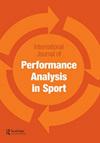Comparison of the activity profile during Grand Slam women’s doubles tennis
IF 1.6
4区 教育学
Q1 Health Professions
International Journal of Performance Analysis in Sport
Pub Date : 2021-09-07
DOI:10.1080/24748668.2021.1972611
引用次数: 2
Abstract
ABSTRACT There is little information on the female doubles tennis. The aim of this study was to describe the activity profile of women’s doubles tennis, and to analyse the differences between playing surfaces. Twenty-one matches of three Grand Slams (GS) tournaments and played on 3 different surfaces, were analysed. Activity profile included rally duration (RD), resting time between points (RTP), resting time between games (RTG), resting time between sets (RTS), resting time (RT), effective playing time (EPT), total match time (TMT), work-to-rest ratio (W: R), shots per rally (SPR), shots per game (SPG), shots per set (SPS), shots per match (SPM), shot frequency (shots/second) (SPSc), and type of shots. Results showed that RTG and RT was longer at the Australian Open than at Roland Garros and Wimbledon, and the number of forehand (F) shots at Roland Garros was higher than at Wimbledon. The most common tennis shots are the F, the backhand (B), the first service and the volley (V), and more than 50% of the total shots in a match come from the baseline and mid court game. These results show that in women’s doubles the stimuli are short and intense and that net game is very important.大满贯女子双打比赛中运动员活动特征的比较
关于女子双打的资料很少。本研究的目的是描述女子双打网球的活动概况,并分析不同场地的差异。三场大满贯(GS)比赛的21场比赛在三个不同的场地进行了分析。活动概况包括回合持续时间(RD)、点与点之间的休息时间(RTP)、局与局之间的休息时间(RTG)、局与局之间的休息时间(RTS)、休息时间(RT)、有效比赛时间(EPT)、总比赛时间(TMT)、工作与休息比(W: R)、每场比赛的射门次数(SPR)、每场比赛的射门次数(SPG)、每场比赛的射门次数(SPS)、每场比赛的射门次数(SPM)、射门频率(每秒射门次数)(SPSc)和射门类型。结果表明,澳网的RTG和RT比罗兰加洛斯和温布尔登更长,罗兰加洛斯的正手击球次数(F)高于温布尔登。最常见的网球击球是F、反手(B)、第一发球和截击(V),一场比赛中超过50%的击球来自底线和中场。这些结果表明,在女子双打比赛中,刺激时间短而强度大,网下比赛是非常重要的。
本文章由计算机程序翻译,如有差异,请以英文原文为准。
求助全文
约1分钟内获得全文
求助全文
来源期刊

International Journal of Performance Analysis in Sport
SPORT SCIENCES-
CiteScore
4.70
自引率
4.80%
发文量
38
审稿时长
>12 weeks
期刊介绍:
The International Journal of Performance Analysis in Sport aims to present current original research into sports performance. In so doing, the journal contributes to our general knowledge of sports performance making findings available to a wide audience of academics and practitioners.
 求助内容:
求助内容: 应助结果提醒方式:
应助结果提醒方式:


